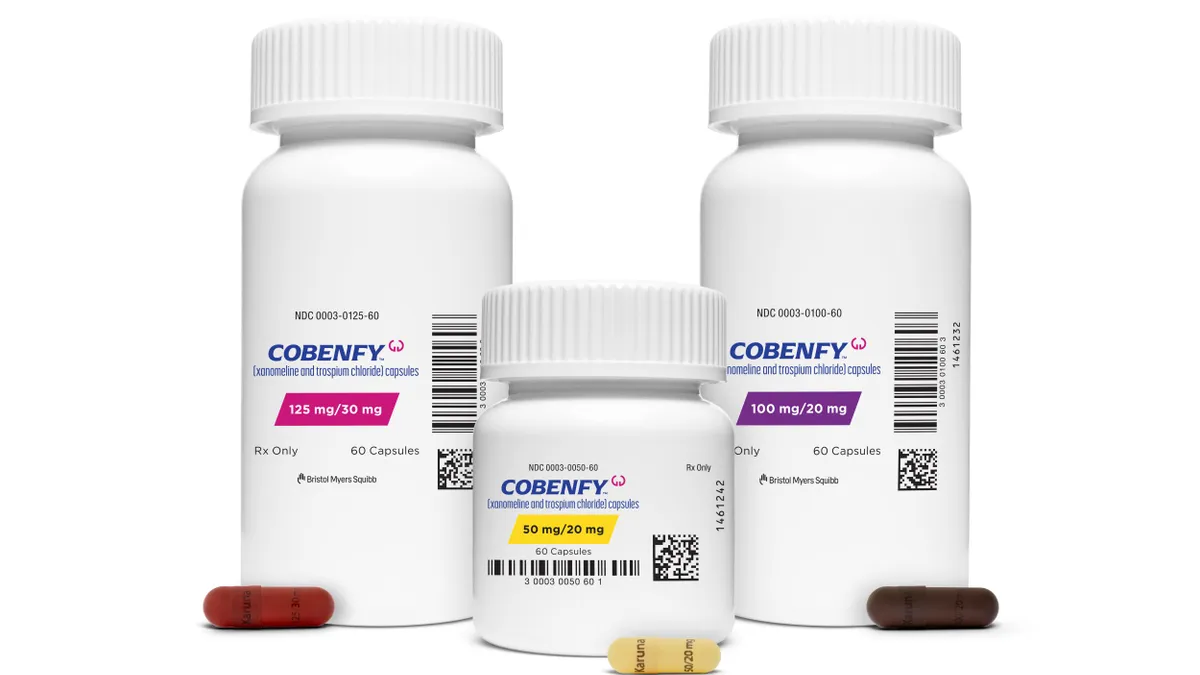The principal investigator (PI) landscape is in flux. According a 2015 survey from the Tufts Center for the Study of Drug Development, persistently high turnover rates among PIs create instability and present an additional challenge for sponsors and CROs.
While the number of investigators globally now stands at almost 40,000, half of them were new to the job in 2013, the most recent year for which data are available, according to Tufts CSDD. In addition, although the highest turnover rates are observed among the least active investigators, turnover rates have been getting progressively worse among more active investigators. In fact, since 2006, 55% of PIs in Europe, 53% in Asia/Pacific, and 40% in North America have not conducted another clinical trial.
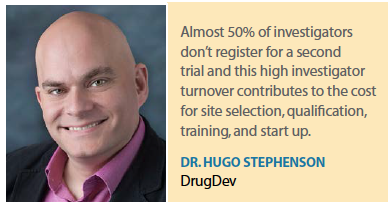 “Investigator turnover is a very significant issue for the industry," says Hugo Stephenson, MBBS, executive chairman, DrugDev. “Almost 50% of investigators don’t register for a second trial and this high investigator turnover contributes to the cost of site selection, qualification, training, and up. Several issues need to be addressed to curtail this ‘one and done’ trend, including the complexity of protocols and administrative burdens."
“Investigator turnover is a very significant issue for the industry," says Hugo Stephenson, MBBS, executive chairman, DrugDev. “Almost 50% of investigators don’t register for a second trial and this high investigator turnover contributes to the cost of site selection, qualification, training, and up. Several issues need to be addressed to curtail this ‘one and done’ trend, including the complexity of protocols and administrative burdens."
In some cases, investigators conduct clinical trials because they think it’s a way to gain access to new therapies for their patients, says Stephen Powell, executive director, strategic feasibility, site intelligence and activation, PPD.
“They find, however, that there are huge burdens in terms of the resources needed for a clinical trial," he says. “For example, they may have an office manager who takes on the additional task of being a study coordinator, then they realize the amount of time it takes to manage the study. Frequently, investigators do one study and realize that maybe this isn’t for them."
PPD, Mr. Powell says, tries to work with experienced investigators, but the pool of experienced investigators is shrinking by 3% every year.
“In certain populations and indications, the lack of experienced investigators becomes an even greater challenge; we’re always trying to find new investigators and bring them in," he says.
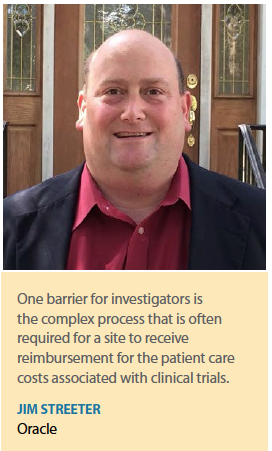 Clare Grace, Ph.D., VP, site and patient access at INC Research, agrees that the lack of new investigators is a challenge.
Clare Grace, Ph.D., VP, site and patient access at INC Research, agrees that the lack of new investigators is a challenge.
“There is a depleting pool of investigators and many current investigators are coming to the end of their working careers," she says. “Research has become much more challenging to execute and less attractive as a career choice due to diminishing returns and challenges to success."
Additionally, many new investigators may not have the dedicated time to do research within their organizations, which may reduce their willingness to participate or enroll subjects in clinical trials, says Jim Streeter, global VP, life sciences product strategy at Oracle.
“This time commitment and other barriers are contributing to the large number of investigators who complete one clinical trial and never sign up for additional trials," he says. “Clinical trials require additional training for investigator site staff, training related to both protocols and systems for the applications used to collected clinical trial data. Data entry also can be time-consuming for site staff, which is working to manage patient care. A third area that is a barrier for investigators who have participated in a clinical trial is the complex reimbursement process for the patient care costs from clinical trials."
April Mulroney, managing director, payments, Medidata Solutions, believes site payments should run like a well-oiled machine; yet, pain points in today’s reimbursement model have broken what should be a seamless process, resulting in inaccurate and late payments.
“Sponsors and CROs are challenged to address high volumes of invoices and complex payment terms using manual data entry systems, such as spreadsheets," Ms. Mulroney says. “This time-consuming, error-prone process delays payments to sites, which lead to high turnover rates among clinical investigators. It’s only a matter of time when clinical sites will no longer be faced with delayed or inaccurate payments, enabling both sites and sponsors to focus less on financial administration and more on the truly important aspects of clinical research."
A recent Cutting Edge Information benchmarking study found that across all surveyed drug companies, 81% pay their clinical investigators on a per-patient basis. Per-patient costs are the primary factor in determining drug companies’ clinical trial budgets. (See related story: Why Sites Matter)
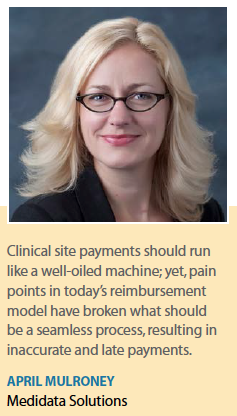 A pharmaceutical company’s investigator compensation strategy is crucial to validate physician payments to regulators. By paying per patient, the schedule aligns investigator priorities with the company’s patient recruitment and retention goals. Another advantage of pay-per-patient is that sponsors determine the fair-market value cost of services performed during a patient’s visit.
A pharmaceutical company’s investigator compensation strategy is crucial to validate physician payments to regulators. By paying per patient, the schedule aligns investigator priorities with the company’s patient recruitment and retention goals. Another advantage of pay-per-patient is that sponsors determine the fair-market value cost of services performed during a patient’s visit.
Dr. Stephenson says one of the biggest barriers for investigators who want to do research is the disproportionately high level of administrative overhead — paperwork, regulatory, and IT — associated with running clinical trials.
“This overhead — which is additional to the clinical responsibilities associated with running the protocol itself — usually exceeds the expectations and budget allocation of most physicians," he says. “As a result, physicians don’t adequately resource to address this overhead, and find themselves stuck with a bad deal. For example, before EDC, data entry was done by the sponsor/CRO; over time the responsibility for entering data into complex systems has become the responsibility of the site, usually without additional compensation."
A well-resourced, profitable site will deliver better, faster service than a poorly resourced, struggling site, Dr. Stephenson says.
“By either reducing the administrative overhead or by compensating for it can benefit all parties by," he says. “Today, new processes, new systems, and new expectations get placed on sites without additional compensation, the overhead being borne from risk aversion. For example, a sponsor might expect sites to respond to queries within 24 hours but if the site’s compensation is based on patient visits and procedures, and there is no patient visit scheduled for another two weeks, would the sponsor be willing to wait two weeks to get a response? We are seeing sites drop out of the market as a result of this dynamic. Once payment terms better reflect the service level and effort required, we will start seeing economics strike a better balance."
This is supported by a survey done by DrugDev in 2013. Across all countries, the need for practical support in conducting clinical trials was cited as a key barrier to investigator participation. In the DrugDev survey, when investigators are asked why more doctors are not participating in industry-sponsored clinical research, the global results showed more than 80% of respondents strongly or somewhat agreed on the following contributing factors: not enough time, not enough resources, and too complicated.
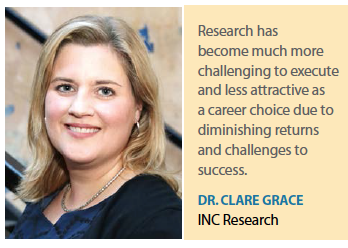 Physicians who do participate in research say they do so primarily for altruistic motivations. The top three factors, ranked in order of importance globally, were: being involved at the forefront of research (the top-ranking answer from 51.3% of respondents); to benefit current patients (31.5%); and to benefit future patients (10.4%).
Physicians who do participate in research say they do so primarily for altruistic motivations. The top three factors, ranked in order of importance globally, were: being involved at the forefront of research (the top-ranking answer from 51.3% of respondents); to benefit current patients (31.5%); and to benefit future patients (10.4%).
Another limitation for physicians who want to do clinical research is technology. A recent DrugDev survey of investigators and technology found that while 80% of investigators have access to a computer for clinical data collection, it is most often a desktop PC (85%) and may not be in every exam room.
Access to a dedicated mobile device or tablet for clinical trial data collection at the investigator site was much lower (less than 15%). As a result, technology solutions involving a mobile device or tablet will likely require capital expense at the site level, provision of devices by the study sponsor, or the ability to use the solution on a staff member’s or patient’s own device.
Recruiting Investigators
Jeff Zucker, VP of feasibility and recruitment, at Worldwide Clinical, says one challenge in recruiting principal investigators is awareness.
“We need to be more proactive in reaching out to physicians who have interest in doing clinical trials," he says. “And we need to help them understand the infrastructure and educate them about what’s needed to conduct clinical trials. It takes a lot of effort and quite frankly, a lot of time and investment to become an investigator. Having that discussion with them is important for finding the right investigators who want to do research is important."
Dr. Stephenson says the biggest trend in recruiting investigators is the increased use of data to drive feasibility and site selection.
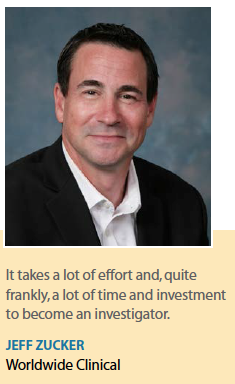 “In the past, organizations had to rely on their own limited experience running their own protocols to inform these decisions, and the data was patchy at best," he says. “Now, through initiatives such as TransCelerate’s adoption of the DrugDev Golden Number and Investigator Registry, it is possible for sponsors and CROs to analyze a much less patchy landscape of operational data by easily consolidating data within organizations and sharing data with their partners."
“In the past, organizations had to rely on their own limited experience running their own protocols to inform these decisions, and the data was patchy at best," he says. “Now, through initiatives such as TransCelerate’s adoption of the DrugDev Golden Number and Investigator Registry, it is possible for sponsors and CROs to analyze a much less patchy landscape of operational data by easily consolidating data within organizations and sharing data with their partners."
DrugDev, Dr. Stephenson points out, was founded by Melissa Easy as an investigator network.
“We’ve always been passionate about making it easier for sites to find clinical trials that match their expertise and developing solutions to help sites and sponsors be more efficient," he says. “DrugDev works closely with the Investigator Databank and the TransCelerate Investigator Registry as well as individual customers to manage and master their investigator data."
Mr. Streeter says many companies both on the sponsor and CRO side are developing investigator networks to meet research needs in particular therapeutic areas that may have been challenging to recruit investigator sites and enroll subjects previously.
“These networks are intended to provide faster start-up times and accelerated subject enrollment in these areas," he says. “We are also seeing the emergence of technology that can simplify the study start-up process for investigator sites, by providing access to training materials, clinical trial systems, and electronic document capabilities through Web portal technologies. Additionally, organizations in the clinical trial space, such as the Society for Clinical Research Sites are working to further reduce the burden on investigators by creating ways to recognize standard training, such as GCP training across studies and sponsors."
PPD, Mr. Powell says, takes a patient-centric approach to recruiting clinical investigators.
“We put together a patient profile that tells us what type of patients are needed specifically for the protocol; if there’s, for instance, socioeconomic considerations, geographic considerations, and then we start looking at who sees those patients," he says. “Then we identify those investigators who have sufficient patient population. Some of that’s done through examination of demographic data, epidemiological data around disease instance and prevalence, and some of that is looking at EMR systems where they could be identified for numbers of patients where we can identify which investigators see the larger numbers of patients and where those are located. So it allows us to be more precise with our site identification. Of course the patient ID is protected from our access."
Dr. Grace says INC Research is working in partnership with the Center for Information and Study on Clinical Research Participation (CISCRP) to increase awareness of clinical trial participation among patients, healthcare professionals, and the general public through a unique competition style format called the Inspiring Hope Ideathon. The Ideathon will culminate in a two-day, face-to-face competition in September in Boston, and the winning idea will be developed by a consortium of participants. (See the October issue of PharmaVOICE for winning initiatives.)
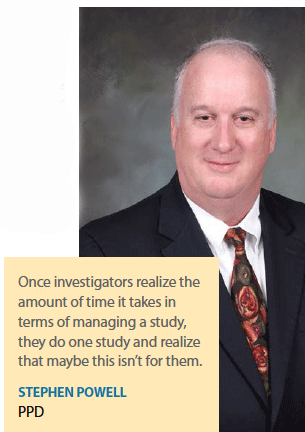 “We believe this initiative will ultimately lead to multiple solutions that the industry can drive forward to support raising awareness of clinical trials, and inevitably attract more physicians who want to be part of research that involves bringing new and potentially life-saving medicines to markets," she says.
“We believe this initiative will ultimately lead to multiple solutions that the industry can drive forward to support raising awareness of clinical trials, and inevitably attract more physicians who want to be part of research that involves bringing new and potentially life-saving medicines to markets," she says.
Globally, in countries where research has been successfully integrated into the care setting, such as the progress made by the NHIR in the United Kingdom, we are starting to see higher participation rates than in other countries, Dr. Grace says.
Mr. Zucker says recruiting physicians for clinical research involves people on the ground.
“This is a face-to-face world, although technology can help," he says. “We’ve moved away from that personal touch with virtual meetings and other technology solutions, but we need to remember investigator recruitment should be a face-to-face effort. It’s essential to have a local person to visit the site and talk with physicians about the pros and the cons of becoming involved in clinical research."
Mr. Powell says there is a lot of opportunity to recruit physicians for research in community-based centers.
“Large academic centers and academic hospitals are fantastic for early phase and more technical studies or for studies for later lines of treatment," he says. (PV)





